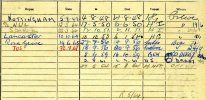I'm looking at a particular period, September 1967 and steam locomotives.
I notice at Rose Grove MDP, 9/9/67 there were 21 8f locomotives sighted, of which 8 were listed as withdrawn.
BR was phasing out the steam locomotives at a fast rate by now, but I was wondering why a particular engine would have been withdrawn, as some of the 8f still in use were older / newer ones than some of the withdrawn ones.
Was it as simple as that if an engine developed a fault and it wasn't worth fixing it the reason?
Did they have too many engines left and there was not enough work for them all? and if so why that engine?
Just the look of the draw?
Or a combination of the above?
Just curious as to what you all might have to say about it...
Thanks,
Andy.
I notice at Rose Grove MDP, 9/9/67 there were 21 8f locomotives sighted, of which 8 were listed as withdrawn.
BR was phasing out the steam locomotives at a fast rate by now, but I was wondering why a particular engine would have been withdrawn, as some of the 8f still in use were older / newer ones than some of the withdrawn ones.
Was it as simple as that if an engine developed a fault and it wasn't worth fixing it the reason?
Did they have too many engines left and there was not enough work for them all? and if so why that engine?
Just the look of the draw?
Or a combination of the above?
Just curious as to what you all might have to say about it...
Thanks,
Andy.

